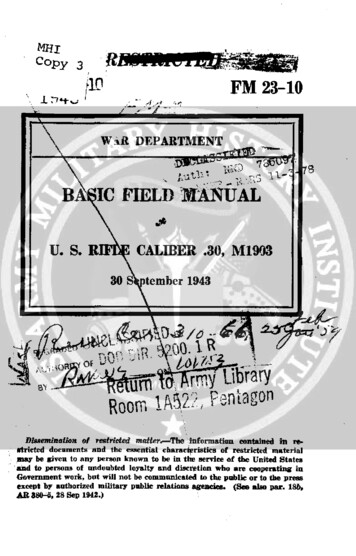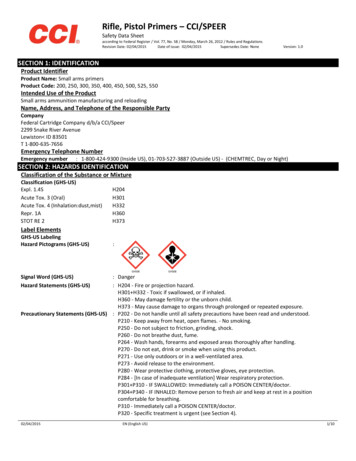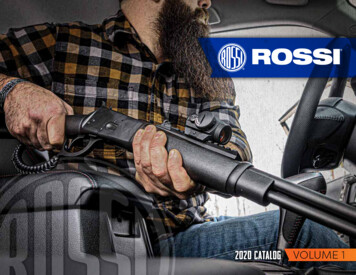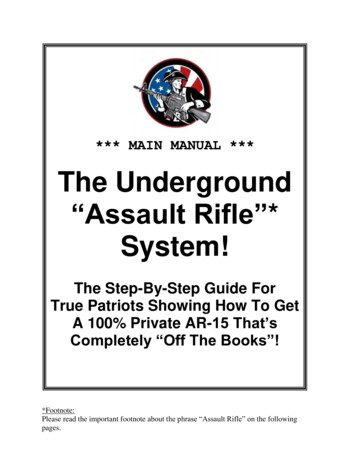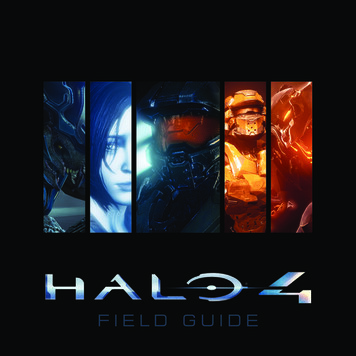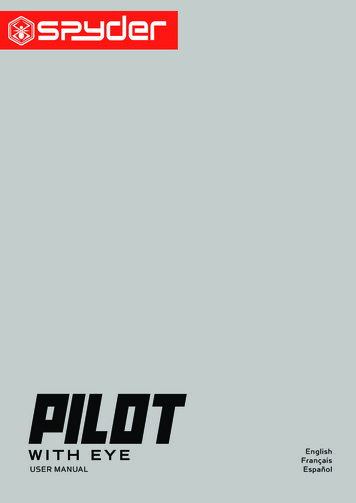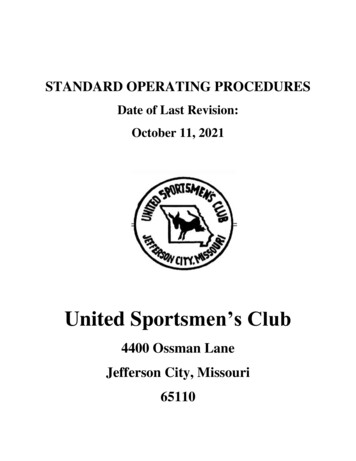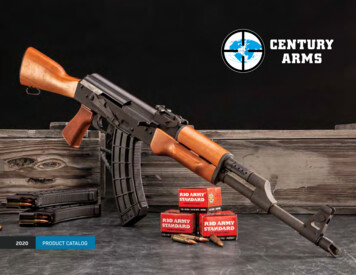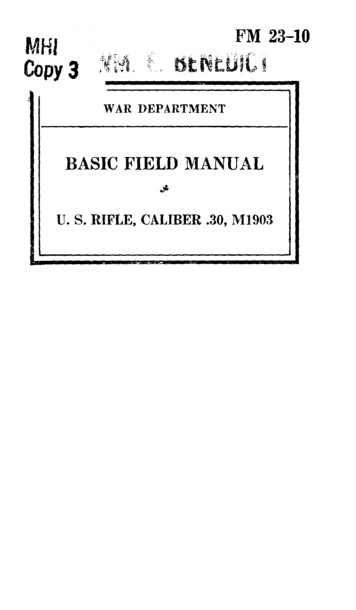
Transcription
FM 23-10Copy3ai- tktWAR DEPARTMENTBASIC FIELD MANUALU. S. RIFLE, CALIBER .30, M1903
FM 23-10BASIC FIELD MANUALU. S. RIFLE, CALIBER .30, M1903Prepared under direction of theChief of InfantryUNITED STATESGOVERNMENT PRINTING OFFICEWASHINGTON: 1940For sale by the Superintendent of Documents, Washington. D. C.Price 25 cents
WAR DEPARTMENT,WASHINGTON, January 2, 1940.FM 23-10, Basic Field Manual, U. S. Rifle, Caliber .30,M1903, is published for the information and guidance of allconcerned.[A. G. 062.11 (9-14-39).]BY ORDER OF THE SECRETARY OF WAR:G. C. MARSHALL,Chief of Staff.Official:E. S. ADAMS,Major General,The Adjutant General.II
TABLE OF CONTENTSParagraphsCHAPTER 1'. MECHANICAL TRAINING:1-5Section I. Description ---------------6-12II. Care and cleaning-------------13III. Functioning-------------------14IV. Individual safety precautions.15V. -KNOWN2.CHAPTERTARGETS:16-23Section I. General ----------------------II. Preparatory marksmanship train24-31ing ------------------------32-36III. Qualification courses -------37-39IV. Range practice -------V. Equipment; known-distance targets and ranges, and range pre40-43cautions ---------------------44-7VI. Small-bore practice ----------CHAPTER 3. MARKSMANSHIP-MOVING GROUNDTARGETS:48-49SECTION I. General -----------------------50-52II. Moving vehicles----------------III. Moving personnel -53-54andranges,targets,IV. Moving55-56safety precautions ---------TARGETS:CHAPTER 4. MARKSMANSHIP-AIR57-58Section I. Nature of air targets for rifle -59-63II. Technique of fire --- ---------64-68III. Antiaircraft marksmanship-----69-72IV. Miniature range practice-------73-77V. Towed-target firing------------78-83VI. Ranges, targets, and equipmentCHAPTER 5. TECHNIQUE OF RIFLE FIRE:Section I. General-----------------------II. Range estimation -------------III. Target designation --------IV. Rifle fire and its effect .V. Application of fire ---------VI. Landscape-target firing .VII. Field-target firing-------------VIII. Fire exercises -----------------CHAPTER 6. ADVICE TO INSTRUCTORS:SectionI. General -----------------------II. Mechanical training------------III. Marksmanship - known-distancetargets ---------------------IV. Marksmanship-air targets ---V. Technique of 08
IVTABLE OF CONTENTSParagraphsPagesAPPENDIX I. AMMUNITION:General ---------------------------------Classification ----------------------------Ammunition lot number ------------ ---Grade ----------------------.------Care, handling, and preservation -Cartridge, ball, caliber .30, M2 and M1 --Precautions in firing blank ammunition.--------------.APPENDIX II. List of references----INDEX 1211212213215
FM 23-10BASIC FIELD MANUALU. S. RIFLE, CALIBER .30, M1903(The matter contained herein supersedes chapter 1, part one,Basic Field Manual, volume III, January 3, 1938; chapter 6, partone, Basic Field Manual, volume III, March 1, 1932 (including C 1,January 2, 1936, and C 2, January 3, 1939); chapter 2, part five,Basic Field Manual, volume III, May 26, 1932; chapter 1, part six,Basic Field Manual, volume III, May 26, 1936; and chapter 2, partsix, Basic Field Manual, volume III, July 15, 1937.)CHAPTER 1MECHANICAL TRAININGSECTION I.II.III.IV.V.ParagraphsDescription- -- 1-5Care and cleaning -----6-12Functioning -- --13Individual safety precautions -14Instruments - - ------------15SECTION IDESCRIPTION1. GENERAL.-The United States rifle, caliber .30, M1903,is a breech-loading magazine rifle of the bolt type. It ispopularly referred to as the Springfield rifle.* 2. PRINCIPALDATA.DIMENSIONS,WEIGHTS,AND MISCELLANEOUSWeight, without bayonet -poundsWeight, with bayonet----- -do-.Length, without bayonet -- -- ---- inchesLength, with bayonet -- -- ---------- .do.Diameter of bore -- ---- -------- do-.Trigger pull, minimum - poundsRifling:Number of grooves --------- -----------Twist, uniform, right, one turn in--- inchesMagazine capacity --- rounds8. 699. 6943 59 .303. 04105
U. S. RIFLE, CALIBER .30, M1903'ilXNFiGURE 1.-U. S. rifle, caliber .30, M1903.2
U. S. RIFLE, CALIBER .30, M19033* 3. REAR SIGHT.--The rear sight is adjustable for windage,and the drift of the bullet to the right is offset automaticallyby the construction of the rear sight leaf. The leaf isgraduated from 100 to 2,850 yards. The lines extendingacross one or both branches of the leaf are 100-yard divisions, the longer of the short lines 50-yard and the shorterlines 25-yard divisions. The drift slide, which may be moved26X(GHFEEP S/I5HTFIGURE 2.-Rear sight.up or down on the leaf, has notches called open sights and acircular hole called the peep sight. With the leaf raised to thevertical position the lines on either side of the peep sight, andthe lower notch, enable the drift slide to be set accurately atany desired graduation on the leaf. With the leaf down andusing the battle sight notch in the slide cap the sights are setfor 547 yards for the down position of the slide.3
3-7U. S. RIFLE, CALIBER.30, M1903The rear end of the rear sight movable base is markedwith wind-gage graduations, each point of which correspondsto a lateral deviation in the point of impact of the bulletof 4 inches for each 100 yards of range to the target.* 4. RATE OF FIREAND EFFECTIVERANGE.-The maximumrate of accurate fire with this weapon depends upon the skilland the position of the operator and the visibility of thetarget. It varies from 10 to 15 shots per minute. Theeffectiveness of rifle fire during combat decreases as therange to the target increases. Its use at ranges greaterthan 600 yards is unusual.E 5. NOMENCLATUREANDREFERENCES.-a.Nomenclature.-The soldier need be familiar with the names of cnly thoseparts of the rifle which are frequently referred to in drilland range practice.b. References.-(1) Safety precautions for observance bytroops are complete in this manual. References to AR 750-10are necessary for range officers, the officer in charge of firing,and the commander responsible for the location of ranges andconduct of firing thereon.(2) See appendix I for data on ammunition for use in theU. S. rifle, caliber .30, M1903.(3) Other information in regard to the rifle necessaryfor supply and administrative purposes by company andhigher headquarters is found in the references listed inappendix II.SECTION IICARE AND CLEANINGR 6. IMPORTANCE.-The care and cleaning of the rifle is animportant duty to be performed by all soldiers armed withthis weapon, and the subject merits the serious considerationof all officers. Experience has shown that the majority ofrifles become unserviceable not through shooting but throughthe lack of intelligent and proper care. In cleaning, the useof abrasives or other harmful materials is forbidden.· 7. INSPECTIONS.-At all inspections, unless otherwiseordered, the rifles will be clean, the bore of the rifle pro4
U.S. RIFLE, CALIBER.30,7-8M1903tected with a thin film of medium rust-preventive compound,the mechanism of the rifle lubricated with thin oil (spermoil), and the oiler filled with oil. When the inspector wishesto inspect the rifles minutely he may order that all greaseand oil be removed from them; but in such cases the greaseand oil will be applied again immediately after the inspection, and the inspector should allot a specific time for sodoing.*1 8. DISASSEMBLING FOR CLEANING.-a.Parts to be removed.-Only the following parts of the rifle may be removed by theindividual soldier for the purpose of cleaning: Front sightcover, floor plate and follower, gun sling, oiler and thongcase, and the bolt.b. To remove the floor plate and follower.-Insert thepoint of a cartridge through the hole in the floor plate andBOLT HANDLESAFETY LUG-SAFETYGRASPING GRO3.FGURE3.press on the floor plate catch. This releases the floor platewhich may then be removed together with the magazinespring and follower. Raise the rear end of the magazinespring high enough to clear the lug on the floor plate anddraw it out of its mortise; in the same manner separate themagazine spring from the follower. To assemble, proceedin reverse order.c. To remove and disassemble the bolt.-Place the cut-offat the center notch; cock the piece by raising and loweringthe bolt handle; turn the safety lock to the vertical position;raise the bolt handle and draw out the bolt to the rear.5
8U. S. RIFLE, CALIBER .30, M1903(See fig. 3.) Press the sleeve lock in with the thumbto unlock the sleeve from the bolt; unscrew the sleeve byturning to the left and remove it. (See fig. 4.) Hold thesleeve between the forefinger and thumb of the left hand;draw the cocking piece back slightly with the middle fingerand thumb of the right hand; turn the safety lock downto the left with the forefinger of the right hand and allowthe cocking piece to move forward in the sleeve. Thispartially relieves the tension of the mainspring. With thecocking piece against the breast, draw back the firing pinsleeve with the forefinger and thumb of the right hand andBOLTSLEEVE\PEEVE LOCKFIGURE 4.hold it in this position while removing the striker with theleft hand. (See fig. 5.) Remove the firing pin sleeve andmainspring; pull the firing pin out of the sleeve. Turn theextractor to the right, forcing its tongue out of its groovein the front of the bolt, and force the extractor forward andoff the bolt. (See fig. 6.)d. To assemble and replace the bolt mechanism.-Turn theextractor collar until its lug is on line with the safety lug onthe bolt; insert the lug on the collar in the undercuts in theextractor by pushing the extractor to the rear until its tonguecomes in contact with the face of the bolt; turn the extractorto the right until it is over the right lug; press the hook of6
U.S. RIFLE, CALIBER8.30, M1903the extractor against some rigid object until the tongue onthe extractor enters its groove in the bolt. (See fig. 7.)COCKING PIECEFIRING PIN RODSAFETY LOCK\l}-STRIKERMAINSPRING/SLEEVE LOCKFIRINGPIN SLEEVEFIGURE 5.With the safety lock turned down to the left, assemble thesleeve and firing pin; place the cocking piece against thebreast and put on mainspring, firing pin sleeve, and striker.TONGUEGROO EBOLT/EXTRACTORFIGURE 6.(See fig. 5.) Hold the cocking piece between the thumb andforefinger of the left hand, and by pressing the striker againstsome object, not hard enough to injure it, force the cocking7
8-9U. S. RIFLE, CALIBER.30, M1903piece back until the safety lock can be turned to the verticalposition with the right hand; insert the firing pin in the boltand screw up the sleeve until the sleeve lock enters its notchon the bolt. Pull the cocking piece back and turn the safetylock to the vertical position. Place the cut-off at the centernotch; hold the piece under the floor plate in the fingers ofthe left hand, the thumb extending over the left side of thereceiver; take the bolt in the right hand with the safety lockin a vertical position and safety lug up; press the rear endof the follower down with the left thumb and push the boltinto the receiver; lower the bolt handle; turn the safety lockand the cut-off down to the left.RIGHT LUGTONGUE-GROOVEBOLTXEXTRACTOR/EXTRACTOR COLLARSAFETY LUGFIGURE 7.*9.CARE AND CLEANING IN GARRISON.-a. Care and cleaningin garrison include the ordinary care of the rifle to preserveits condition and appearance in garrisons, posts, and campsduring those periods when no firing is done.b. Damp air and sweaty hands induce rust. The rifle shouldbe cleaned and protected after every drill. Special precautions are necessary when the rifles have been used on rainydays and after tours of guard duty.c. The barrack cleaning rod should be used. The use ofthe thong and brush will be confined to occasions when thebarrack cleaning rod is not available. To avoid possible injury to the rifling at the muzzle, rifles will be cleaned fromthe breech, the bolt being removed for this purpose.8
U.S. RIFLE, CALIBER.30, M19039-10d. Care should be exercised that the chamber of the rifleis cleaned as thoroughly as is the bore. A roughened chamber may cause shells to stick.e. To clean the rifle, rub it with a rag which has beenslightly oiled, and then wipe it with a dry rag. Swab thebore with an oiled flannel patch and then with a dry one.Dust out all screw heads and crevices with a small, cleanbrush.I. Immediately after cleaning, to protect the rifle, swab thebore thoroughly with a flannel patch saturated with mediumrust-preventive compound; wipe over all metal parts, including the bolt mechanism and magazine, with an oiled rag;apply a few drops of light oil to all cams and working surfacesof the mechanism. Occasionally place a teaspoonful of linseed oil in the palm of the hand and polish the stock well.g. After cleaning and protecting the rifle, place it in thegun rack without any covering whatever. The use of canvasor similar covers for the rifle is prohibited, as they collectmoisture and rust the metal parts. When the barracks arebeing swept, gun racks will be covered to protect the riflesfrom dust.When a rifle hasbeen fired, the bore and chamber must be cleaned thoroughlynot later than the evening of the day on which it is fired.To clean the bore after firing, insert the muzzle in a vesselcontaining hot water and issue soap, hot water alone, orcold water; the cleaning rod with a cloth patch assembled isinserted in the breech and moved forward and back forabout 1 m nute, pumping the water in and out of the bore.While the bore is wet a brass or bronze wire brush, if available, should be run all the way through, then all the wayback, three or four times. Water should again be pumpedthrough the bore. Then wipe the cleaning rod dry, removebarrel from water, and using dry, clean flannel patchesthoroughly swab the bore until it is perfectly dry and clean,being careful that the chamber is also dried and cleaned.Hold the breech of the barrel pointed toward the sky andexamine the bore carefully for metal fouling. The boremust be similarly cleaned and regreased each day for thenext succeeding 3 days to insure that no trace of fouling* 10. CARE AND CLEANING AFTER FIRING.-a.9
10-13U. s. RIFLE, CALIBER .30, M1903remains. Oil will not free the bore of powder fouling-onlywater or solutions containing water will do this.b. If no metal fouling is present, saturate a clean flannelpatch with medium rust-preventive compound or the oilissued for this purpose, and swab the bore and chamberthoroughly, making certain that the bore and all metalparts of the rifle are covered with a thin coating of greaseor oil.c. Small flakes or lumps on the surface of the bore indicate the presence of metal fouling. Should such foulingoccur, the rifle should be turned over to the OrdnanceDepartment. New types of ammunition rarely producemetal fouling.* 11. CARE AND CLEANING IN THE FIELD.-The rifle is cared forin the field in a manner similar to that described in paragraphs 9 and 10. When the barrack cleaning rod is notavailable, the contents of the oiler and thong case, carriedin the butt of the stock, may be used. In cleaning the boreby means of the thong the brush or rag should be drawnfrom the breech toward the muzzle. To prevent noise whilecarrying, the oiler should always be inserted into the stockso that the leather-tipped cap will be next to the butt platecap.e12. RULES WHEN ON THE RANGE.-a. Wipe cut the boreand chamber with a clean cloth patch before the first firingeach day.b. Always clean at the end of each day's shooting.c. Never leave a patch, oily rag, cork, or other obstructionin the bore.d. It is essential for the proper working of all cams thatthey be kept lubricated.SECTION IIIFUNCTIONING* 13. OPERATION.--a. To load.-To load the magazine, turn thecut-off up, showing "on"; draw the bolt fully to the rear andinsert the cartridges from a clip, or singly from the hand.To load from a clip, place one end of a loaded clip into its10
U. S. RIFLE, CALIBER .30, M190313seat in the receiver, and with the fingers of the right handunder the rifle against the floor plate, and the base of thethumb on the powder space of the top cartridge near theclip, press the cartridges down with the thumb into the magazine with a firm, steady push until the top cartridge is caughtby the right edge of the receiver. The empty clip is removedwith the right hand. After loading the magazine, to placea round in the chamber, close the bolt. As the bolt is closedthe top cartridge in the magazine is pushed forward into thechamber. When the rifle is used as a single loader, cartridgesare inserted directly into the chamber with the hand, thecut-off being turned down.b. Extraction.-Extraction of the empty case from thechamber by the extractor is started during the rotation ofthe bolt and is completed as the bolt is drawn to the rear.c. Ejection.-When the bolt is drawn fully to the rear thehead of the case strikes against the ejector point and the caseis ejected from the receiver.d. Cut-off.-When the cut-off is up and the bolt fullyto the rear, the top cartridge in the magazine is forced up intothe path of the bolt by the magazine spring. When thecut-off is turned down the magazine is "off." The bolt cannot be drawn fully back, and its front end, projecting overthe rear end of the upper cartridge, holds the latter down inthe magazine below the action of the bolt. The magazinemechanism then remains inoperative, and the rifle can beused as a single loader with the cartridges in the magazineheld in reserve.e. Follower.-In magazine fire, after the last cartridge hasbeen fired and the bolt drawn fully to the rear, the followerrises and blocks the path of the bolt, thus showing that themagazine is empty. A new clip may then be inserted andthe magazine refilled, or the bolt may be closed without reloading by first forcing the follower down until it is belowthe path of the bolt.f. To unload.-With the cut-off up, move the bolt forwardand back until no cartridges remain in the magazine orchamber.g. Safety device.-To set at safe, which can only be donewhen the piece is cocked, turn the safety lock to the right.11
13-14U. S. RIFLE, CALIBER.30, M1903This locks the firing pin in position and the piece cannot befired. To set at ready, turn the safety lock to the left.h. Cocking.-The piece may be cocked either by raisingthe bolt handle until it strikes the left side of the receiverand then turning it down, or by pulling the cocking piecedirectly to the rear.SECTION IVINDIVIDUAL SAFETY PRECAUTIONSM 14. RLES.--a. Consider every rifle to be loaded until youhave examined it and proved it to be unloaded. Never trustyour memory as to its condition in this respect.b. Never point the rifle at anyone you do not intend toshoot, nor in a direction where an accidental discharge maydo harm.c. Always unload the rifle if it is to be left where someoneelse may handle it.d. Always point the rifle up when snapping the triggerafter examination.e. If it is desired to carry the piece cocked with a cartridgein the chamber, the bolt mechanism should be secured byturning the safety lock to the right.f. Under no circumstances should the firing pin be letdown by hand on a cartridge in the chamber.g. Never fire a rifle with any grease, cleaning patch, dust,dirt, mud, snow, or other obstruction in the bore. To do somay burst the barrel.h. Never grease or oil the ammunition or the walls of therifle chamber. This creates a hazardous pressure on therifle bolt.i. See that the ammunition is clean and dry. Examine alllive and dummy ammunition. Turn in all cartridges withloose bullets or which appear to be otherwise defective.j. Do not allow the ammunition to be exposed to the directrays of the sun for any length of time. This creates hazardous chamber pressures.12
U. S. RIFLE, CALIBER .30, M190315SECTION VINSTRUMENTSU 15. FELD GLASS, TYPE EE.-The field glass, type EE(fig. 8), complete, consists of the'field glass with its carryingcase.a. Description.-(1) The field glass consists of two compact prismatic telescopes (5) pivoted about a common hinge(4) which permits adjustment for interpupillary distances.A scale (3), graduated every 2 millimeters from 56 to 74,permits the observer rapidly to set the telescope to suit hiseye distance when the spacing of his eyes is known. Theeyepiece (1) can be focused independently for each eye byscrewing in or out. Each is provided with a diopter scale(2) for rapid setting when the observer knows the correctionfor his eye. The zero graduations indicate the settings fornormal eyes.(2) The left telescope is fitted with a glass reticle (fig. 9)upon which are etched a vertical mil scale, a horizontal milscale, and a stadia graduated similarly to the sight leafgraduation on the service rifle.b. Use.-The field glass is used for observations and themeasurement of small horizontal and vertical angles in mils.The vertical stadia scale (inverted sight leaf) is used to pickup auxiliary aiming marks in direct laying and to determinetroop safety for overhead fire.c. Preliminary adjustments; interpupillary distances.-Toadjust the glass so that the eyepieces are the same distanceapart as the pupils of the observer's eyes, point the glassat the sky and open or close the hinged joint until the fieldof view ceases to be two overlapping circles and appearsto be one sharply defined circle. Note the reading on the,scale (3), which indicates the spacing of the observer's eyes.The similar setting of any other field glass will thenaccommodate his eyes.d. Focus of the eyepiece.-Look through the glasses, botheyes open, at an object several hundred yards away. Placethe hand over the front of one telescope and screw the eyepiece of the other in or out until the object is sharply defined. Repeat this operation for the other eye and note the197334'--40-213
15U. S. RIFLE, CALIBER .30, M1903IH I I Iia i:j: P316
U. S. RIFLE, CALIBER.30, M190315-10302010-1510203020FIGURE 9.-Reticle graduations, field glass, type EE.reading on the diopter scale. The similar setting of anyother field glass will accommodate the eyes.e. Operation.--(1) In using the glass it should be held inboth hands and pressed lightly to the eyes so as to keep therelation with the eyes constant without transmitting tremorsfrom the body. The bent thumbs should fit into the outeredges of the eye sockets in such a manner as to prevent lightfrom entering in rear of the eyepieces. When possible it isbest to use a rest for the glass or elbows.(2) The mil scales are seen when locking through theglass, and by superimposing them upon the required objectsthe horizontal and vertical angles may be read betweenthese objects.f. Care.-The field glass is a rugged, serviceable instrument but should not be abused or roughly handled.15
CHAPTER al y marksmanship training32-36Qualification courses -.----------------37-39Range practice------------------------Equipment; known-distance targets and40-43ranges; range precautions -----------44-47VI. Small-bore practice --------------------SECTION I.II.III.IV.V.SECTION IGENERAL* 16. PURPOSE.-The purpose of this chapter is to provide athorough and uniform method of training individuals to begood rifle shots and of testing their proficiency in firing atknown-distance targets.* 17. NECESSITY FOR TRAINING.-a. Without proper traininga man instinctively does the wrong thing in firing the rifle.He gives the trigger a sudden pressure which causes flinching.However, if he is thoroughly instructed and drilled in themechanism of correct shooting, and is then carefully andproperly coached when he begins firing, he rapidly acquirescorrect shooting habits. It is much easier to develop intoan excellent shot a man who has never fired a rifle, than itis to correct the errors of a man who has done a good dealof shooting under improper supervision.b. Rifle firing is a mechanical operation which anyone whois physically and mentally fit to be a soldier can learn to dowell if properly instructed. The methods of instruction arethe same as those used in teaching any mechanical operation.The training is divided into steps which must be taught inproper sequence. The soldier is carefully coached and iscorrected whenever he starts to make a mistake.16
U. S. RIFLE, CALIBER .30, M190318-20* 18. FUNDAMENTALS.-To become a good rifle shot the soldier must be thoroughly trained in the following essentialsof good shooting:a. Correct sighting and aiming.b. Correct positions.c. Correct trigger squeeze.d. Correct application of rapid fire principles.e. Knowledge of proper sight adjustments.* 19. PHASES OF TRAINING.--a. Marksmanship training isdivided into the following phases:(1) Preparatory marksmanship training.(2) Range practice.b. No individual should be given range practice until hehas had a thorough course in preparatory training.c. The soldier should be proficient in mechanical trainingbefore he receives instruction in marksmanship training.d. Every man who is to fire on the range will be put throughthe entire preparatory course. No distinction will be madebetween recruits and men who have had range practice, regardless of their previous qualification. Some part of thepreparatory instruction may have escaped them in previousyears; it is certain that some of it has been forgotten, and inany case it will be helpful to go over it again and refresh themind on the subject.e. When necessary and when time permits, all of the noncommissioned officers of the company should be put througha course of instruction and required to pass a rigid test before the period. of preparatory training for the companybegins.* 20. PRACTICE SEASONS.-a. Regular.-(1) Under ordinaryconditions the regular practice season for the Regular Armywill cover a period of not more than 3 weeks for each organization. A period of 1 week should be devoted to preparatoryexercises and 2 weeks to range practice. When unforeseen circumstances are such as to cause a delay during the period ofinstruction, the time may be extended by the post commander.(2) The regular practice season for units of the NationalGuard and other components of the Army will be of suchduration and ordered at such times as may be best suited foreffective training.17
20-23u. s. RIFLE, CALIBER.30, M1903(3) It is advisable that battalions or smaller units berelieved from routine garrison duty during the period ofpreparatory training and range practice.(4) In order that officers and enlisted men of the RegularArmy, National Guard, and Organized Reserves may be familiar with their exact duties of marksmanship training duringmobilization, organizations should not exceed the number ofhours set forth in model schedules (par. 141). Under no conditions will any man be given range practice until he hashad a thorough course in the preparatory exercises.b. Supplementary.-Supplementary practice is not necessary when the regular practice season has been efficientlyconducted, except in cases where a large number of unqualified men join the organization after the regular practice season. The supplementary practice season is usually placedas late in the fall as is consistent with efficient instruction.However, this practice may be held at any time when circumstances make it advisable.* 21. CoNTINUOUS PRACTICE.-Rifle practice is not limited toa particular season. Subject to ammunition allowances, commanding officers will adopt such measures as may be necessary to maintain a high state of excellence in rifle firingthroughout the year. The particular measures adopted willdepend upon the facilities near the post or station. Themeasures taken may provide for competitions between individuals or organizations or the encouragement of small-borerifle teams.U 22. RECRUIT INSTRUCTION.-As part of their recruit training, all recruits armed with the rifle will be thoroughly instructed in mechanical training and in the fundamentalelements of rifle marksmanship-sighting and aiming, positions, trigger squeeze, and rapid fire. They will be given afinal examination and should fire one of the small-bore qualification courses outlined in paragraph 47. Instruction inrifle marksmanship will commence with the initial instructionof the recruit and will continue throughout. the period ofrecruit training.* 23. LEADERS AND COMMANDERS; DUTIES AND EQUIPMENT.--.Duties.-(1) Squad leader.-(a) Organizes the work in his18
U. S. RIFLE, CALIBER .30, M190323-24squad so that each man is occupied during the preparatoryperiod in the prescribed form of training for target practice.(b) Examines each man in his squad at the end of thetraining on each preparatory step and assigns him a mark inthe proper place on the blank form showing state of training.(c) Sees that each man takes proper care of his rifle andthat he cleans it at the end of each day's firing.(d) Enforces correct aiming, position, and trigger squeezewhen fire is simulated in drills and maneuvers.(2) Platoon leader.-Supervises and directs the squadleader in training his squad; personally checks each man inhis platoon on the points enumerated on the blank form; andexamines each man along the lines outlined in paragraph 31.(3) Company commander.-Requires the prescribed methods of instruction and coaching to be carried out carefullyand in detail; supervises and directs the squad and platoonleaders
FM 23-10 BASIC FIELD MANUAL U. S. RIFLE, CALIBER .30, M1903 (The matter contained herein supersedes chapter 1, part one, Basic Field Manual, volume III, January 3, 1938; chapter 6, part one, Basic Field Manual, volume III, March 1, 1932 (including C 1,
